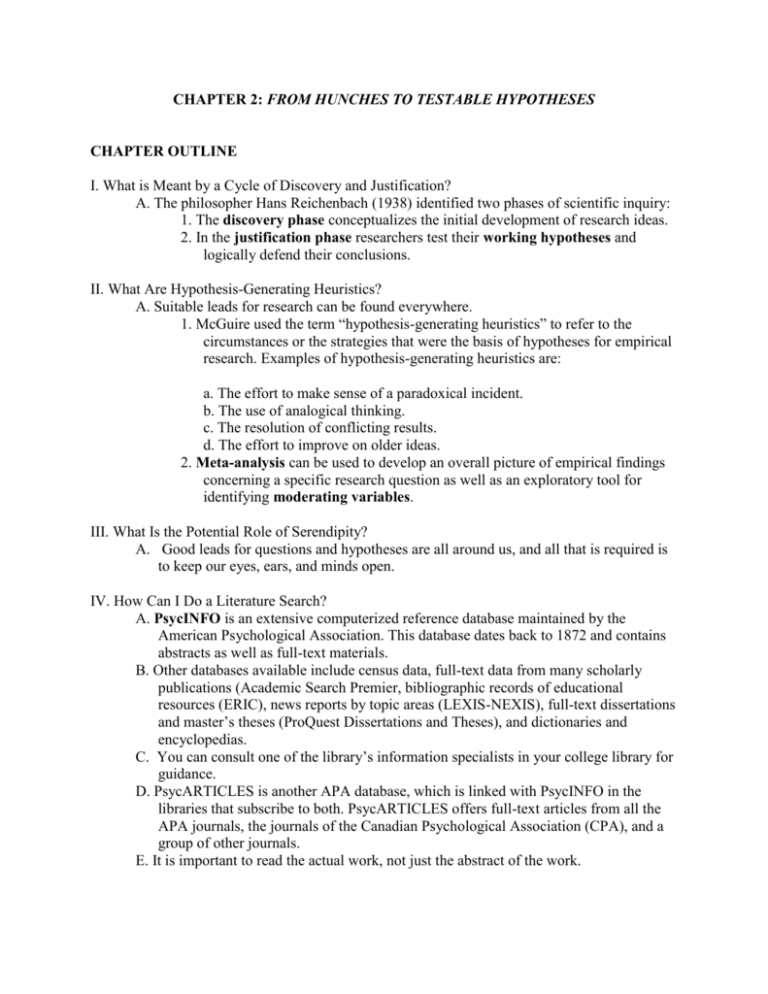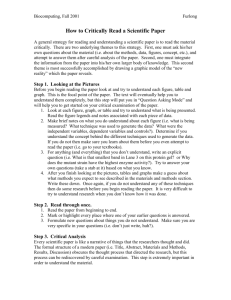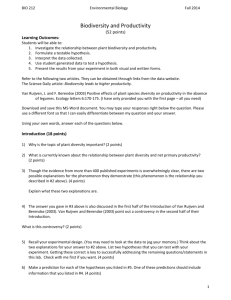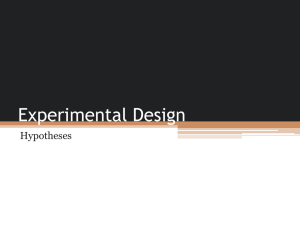CHAPTER 2: FROM HUNCHES TO TESTABLE HYPOTHESES
advertisement

CHAPTER 2: FROM HUNCHES TO TESTABLE HYPOTHESES CHAPTER OUTLINE I. What is Meant by a Cycle of Discovery and Justification? A. The philosopher Hans Reichenbach (1938) identified two phases of scientific inquiry: 1. The discovery phase conceptualizes the initial development of research ideas. 2. In the justification phase researchers test their working hypotheses and logically defend their conclusions. II. What Are Hypothesis-Generating Heuristics? A. Suitable leads for research can be found everywhere. 1. McGuire used the term “hypothesis-generating heuristics” to refer to the circumstances or the strategies that were the basis of hypotheses for empirical research. Examples of hypothesis-generating heuristics are: a. The effort to make sense of a paradoxical incident. b. The use of analogical thinking. c. The resolution of conflicting results. d. The effort to improve on older ideas. 2. Meta-analysis can be used to develop an overall picture of empirical findings concerning a specific research question as well as an exploratory tool for identifying moderating variables. III. What Is the Potential Role of Serendipity? A. Good leads for questions and hypotheses are all around us, and all that is required is to keep our eyes, ears, and minds open. IV. How Can I Do a Literature Search? A. PsycINFO is an extensive computerized reference database maintained by the American Psychological Association. This database dates back to 1872 and contains abstracts as well as full-text materials. B. Other databases available include census data, full-text data from many scholarly publications (Academic Search Premier, bibliographic records of educational resources (ERIC), news reports by topic areas (LEXIS-NEXIS), full-text dissertations and master’s theses (ProQuest Dissertations and Theses), and dictionaries and encyclopedias. C. You can consult one of the library’s information specialists in your college library for guidance. D. PsycARTICLES is another APA database, which is linked with PsycINFO in the libraries that subscribe to both. PsycARTICLES offers full-text articles from all the APA journals, the journals of the Canadian Psychological Association (CPA), and a group of other journals. E. It is important to read the actual work, not just the abstract of the work. V. How Should I Go About Defining Variables? A. One should begin to think about naming and defining the things one wants to study. B. Operational definitions identify terms on the basis of the empirical conditions used to measure or manipulate them. C. Theoretical (or conceptual) definitions assign the meaning of terms more abstractly or generally. D. There are reference sources available that can aid in the development of good operational and theoretical definitions of variables one wishes to study. VI. What Identifies “Good” Theories and Working Hypotheses? A. The research idea is molded into a testable supposition, or working hypothesis (also called an experimental hypothesis in experimental research) based on theory. B. There is a distinction usually made between hypotheses and theories. 1. A hypothesis is a conjectural statement or supposition. a. Hypotheses can be derived from a theory. b. Hypotheses give direction to the researcher’s systematic observations. 2. A theory is an organized set of explanatory propositions connected by logical arguments and by explicit and implicit prior assumptions. a. A theory postulates a kind of conceptual pattern, which can then serve as a logical framework for the interpretation or the larger meaning of one’s observations. b. Seminal theories shape or stimulate other work. c. Good scientific theories are generative, which means they encourage others to generate additional hypotheses. C. Molding Ideas Into Acceptable Hypotheses 1. A working hypothesis must be plausible, that is, it must have correspondence with reality in that it agrees with accepted truths (e.g., other respected theories and reliable empirical data). 2. Falsifiability is the most essential criterion for an acceptable hypothesis according to the philosopher Karl Popper. Hypotheses that do not meet this criterion are considered to be outside the realm of science. 3. A hypothesis must be succinct, which is a combination of coherence and parsimony. a. Coherence refers to whether the hypothesis “sticks together” in a logically compelling way. b. Parsimony refers to how “sparing” or “frugal” the hypothesis is. Occam’s razor refers to the ruminative and winnowing process of eliminating the superfluous. VII. What is the Distinction between an Independent Variable and a Dependent Variable? A. A variable is an event or condition that the researcher observes or measures or plans to investigate and that is likely to vary or change. 1. The dependent variable is the consequence (or the outcome) in which the researcher is interested. 2. The independent variable is the presumed “cause.” Changes in this variable lead to changes in the dependent variable. B. How a variable is labeled always depends on its context. VIII. What Belongs in My Research Proposal? A. A proposal might be thought of as a mutual understanding between the student and the instructor. B. By searching the literature and having discussions with one’s instructor, one will be able to develop a rationale for one’s hypothesis. C. A research proposal conveys what one would like to study and how one will go about it. LECTURE IDEAS AND ACTIVITIES 1. One misconception that students may have concerning the research process is that it is a “boring” endeavor that is relatively straightforward, culminating in a published research report. However, as many researchers know, this is far from the truth. To help students come to appreciate the “exciting” side of the research process, discuss how you became interested in your area of research. Relate the personal process you go through as you formulate and eventually test your research ideas. You may also want to discuss the origin of these research ideas, relating to the various sources of research ideas outlined in the text. Along these lines, there are several books available in which researchers focus on the origins of their ideas and the experiences they had along the way as their research endeavors led them down unexpected and interesting paths. Brannigan, G. G., & Merrens, M. R. (Eds.). (1992). The undaunted psychologist: Adventures in research. New York: McGraw-Hill. Brannigan, G. G., & Merrens, M. R. (Eds). (1995). The social psychologist: Research adventures. New York: McGraw-Hill. Merrens, M. R., & Brannigan, G. G. (Eds.). (1996). The developmental psychologists: Research adventures across the lifespan. New York: McGraw-Hill. 2. To illustrate the point that research ideas can be found almost anywhere, begin a discussion of current events. You may want to read the headlines from that day’s newspaper to stimulate this discussion. Have students propose explanations for why these events occurred. After discussing several alternative explanations for the same event, have students shape each of these explanations into plausible research ideas suitable for investigation. 3. The text discusses the role of the literature search in the development of a research proposal. As this may be a student’s first exposure to the psychological literature, the student may be unfamiliar with how to critically read a research article. You may want to take this opportunity to discuss the format of the typical journal article, pointing out the purpose of the different sections (i.e., introduction, method, results, and discussion). Appendix A of the text (“Reporting Your Research Results”) can serve as a guide for this discussion. One aspect of reading an empirical article that can be particularly frustrating for students is the statistical analyses the author employed to test the hypothesis. This lack of understanding may lead the students’ eyes to “glaze over” when reading the results section, thus missing the major findings of the study. You may want to specifically guide students through a results section of a typical research report explaining how students do not necessarily have to have a sophisticated knowledge of statistics to understand and evaluate the author’s major findings and conclusions. 4. Searching the literature can be a daunting task for the beginning researcher, especially for students unfamiliar with the wealth of resources available to behavioral scientists. You may want to discuss how to effectively use library resources to conduct a literature search. Parr (1988) has argued that a general instruction on library usage is a necessary first step in teaching students how to do literature searches. Merriam, LaBaugh, and Butterfield (1999) describe the basic, practical library skills that all psychology students should learn in order to be able to conduct effective literature searches. In addition to the brief discussion of how to find and use reference materials in this chapter, Rosnow and Rosnow (2005) have devoted an entire chapter to this topic in their Writing Papers in Psychology manual. Rosnow and Rosnow familiarize students not only with general library operation (e.g., how material is catalogued) but also the types of resources that are often available to students in their literature search. Merriam, J., LaBaugh, R. T., & Butterfield, N. E. (1999). Library instruction for psychology majors: Minimum training guidelines. In M. E. Ware and C. L. Brewer (Eds.), Handbook for teaching statistics and research methods (2nd ed.) (pp. 154–157). Mahwah, NJ: Lawrence Erlbaum. Parr, V. H. (1996). Course related library instruction for psychology students. In M. E. Ware and D. E. Johnson (Eds.), Handbook of demonstrations and activities in the teaching of psychology, Vol. 1: Introductory, statistics, research methods, and history (pp. 132–133). Mahwah, NJ: Lawrence Erlbaum. Rosnow, R. L., & Rosnow, M. (2005). Writing papers in psychology (7th ed.). Belmont, CA: Wadsworth. 5. As discussed in this chapter, computerized reference databases represent an easy way to search the literature for relevant references. Feinberg, Drews, and Eynman (1996) have suggested that learning to use these databases may have positive effects on students’ attitudes towards the library as well as the literature review process itself (see also Cameron & Hart, 1996). However, using computerized reference databases does have disadvantages which should be discussed with your students (Lewis, 1996). For example, the scope of the database may be limited to articles published only during the past 20–30 years. In addition, the success of one’s literature search is influenced by the effectiveness of the search strategy one uses. Parr (1996) describes a general search strategy she uses when working with students who are learning to conduct searches using computerized databases. Cameron, L., & Hart, J. (1996). Assessment of PsycLIT competence, attitudes, and instructional methods. In M. E. Ware and C. L. Brewer (Eds.), Handbook for teaching statistics and research methods (2nd ed.) (pp. 157–161). Mahwah, NJ: Lawrence Erlbaum. Feinberg, R. A., Drews, D., & Eynman, D. (1996). Positive side effects of online information retrieval. In M. E. Ware and D. E. Johnson (Eds.), Handbook of demonstrations and activities in the teaching of psychology, Vol.1: Introductory, statistics, research methods, and history (pp. 136–137). Mahwah, NJ: Lawrence Erlbaum. Lewis, L. K. (1996). Bibliographic computerized searching in psychology. In M. E. Ware and D. E. Johnson (Eds.), Handbook of demonstrations and activities in the teaching of psychology, Vol.1: Introductory, statistics, research methods, and history (pp.138–140). Mahwah, NJ: Lawrence Erlbaum. 6. One way to motivate your students to learn how to effectively conduct library searches is to use “treasure” or “scavenger” hunts. For example, LeUnes (1988) and Mathews (1988) found that students became more comfortable and efficient with doing literature searches after they learned to use the library to answer specific questions as part of a treasure hunt “game.” For example, who was the author of the chapter on Personality in the 1971 edition of the Annual Review of Psychology? What is the library call number of the Journal of Psychology? (Mathews, p. 115) Name eight educational/psychological journals that deal with studies on the development of children. What book did John Watson write in 1928 pertaining to child development? (LeUnes, p. 114) Gardner (1996) describes another strategy for introducing students to the psychological literature. He provides students with a list of clichés and old sayings (e.g., “opposites attract” or “you can’t teach an old dog new tricks”) that they are to treat as research hypotheses. The students are then told to find empirical evidence in the psychological literature that either supports or refutes their cliché or saying. Students are required to submit the abstracts from the articles they locate as well as defend why those particular articles would be useful in either supporting or negating the validity of the cliché or saying. This last component of Gardner’s exercise is a particularly important aspect of this exercise. While students may become adept at locating articles, they are not necessarily able to evaluate the utility of those articles. By being able to locate the relevant literature and understand how that literature either supports or refutes a research hypothesis, students will gain a better understanding of how to write a clear and focused literature review. Gardner, L. E. (1996). A relatively painless method of introduction to the psychological literature search. In M. E. Ware and D. E. Johnson (Eds.), Handbook of demonstrations and activities in the teaching of psychology, Vol.1: Introductory, statistics, research methods, and history (pp. 129–130). Mahwah, NJ: Lawrence Erlbaum. LeUnes, A. D. (1988). The developmental psychology library search: Can a nonsense assignment make sense? In M. E. Ware and C. L. Brewer (Eds.), Handbook for teaching statistics and research methods (pp. 113–114). Hillsdale, NJ: Lawrence Erlbaum. Mathews, J. B. (1996). “Hunting” for psychological literature: A methodology for the introductory research course. In M. E. Ware and D. E. Johnson (Eds.), Handbook of demonstrations and activities in the teaching of psychology, Vol. 1: Introductory, statistics, research methods, and history (pp. 131–132). Mahwah, NJ: Lawrence Erlbaum. 7. To help students learn to identify the independent and dependent variables associated with a research question, have them identify the relevant independent and dependent variables in each question below. Then have them provide an operational definition for each. 1. Do blondes have more fun? 2. Does taking vitamins increase brain power? 3. Does age affect how well you can exercise? 4. Does interacting with relatives cause anxiety? 5. Does living in close quarters increase the desire to hurt others? 6. Does exposure to repeated disappointment result in sadness? 7. Is physical attractiveness related to arrogance? 8. Do children have more behavioral problems when both parents have careers? 9. Do patient people take longer to get to the center of a Tootsie Roll Pop? MULTIPLE-CHOICE QUESTIONS 1. 2. 3. According to the philosopher Hans Reichenbach, it is during the __________ stage of research that scientists formulate the ideas they pursue using the scientific method. a. empirical b. justification * c. discovery d. final (20) One has entered the __________ stage of research when scientists actually begin to test their working hypotheses and logically defend their conclusions. a. discovery b. plausibility c. initial * d. justification (20) Name one example of a hypothesis-generating heuristic. * a. explaining paradoxical incidents in testable ways b. identifying the operational definition c. falsifiability d. the consequence (or the outcome) in which the researcher is interested (22) 4. Irving Janis was fascinated by how a group of intelligent men such as President John F. Kennedy and his advisors could make such a disastrous decision when they authorized the ill-fated Bay of Pigs invasion. To find out, Janis began his study of decision-making in groups that eventually led to the phenomenon of “groupthink.” Janis’s hypothesisgenerating heuristic could best be described as a. an attempt to resolve conflicting results. * b. an effort to understand a paradoxical incident. c. an effort to improve on older ideas. d. the use of metaphors. (22) 5. The inspiration for Robert Zajonc’s research that ultimately led to his theory of social facilitation was a. his desire to improve on older ideas and theories. b. his use of analogical thinking. c. his trying to make sense of a paradoxical incident. * d. his attempt to resolve conflicting results. (23) 6. While studying possible factors related to heart disease, two cardiologists, Meyer Freidman and Ray Rosenman, noticed that there were discernible differences in behavioral patterns between men who were and were not prone to coronary problems. This observation led to the identification of Type A and Type B personality types. The source of Friedman and Rosenman’s initial research idea can best be described as a. the use of metaphors. * b. serendipity. c. resolution of conflicting ideas. d. improvement on old ideas. (25-26) 7. Databases that are used in psychological research and can be found in the college library include all but which of the following? * a. PROinfo b. PsycINFO c. ProQuest Dissertations and Theses d. PsycARTICLES (27) Definitions based on how something will be measured or manipulated are referred to as a. theoretical definitions. b. conceptual definitions. c. precise definitions. * d. operational definitions. (29) 8. 9. A researcher defines frustration as the number of teeth marks a student makes on a pencil while trying to solve a difficult problem. This is an example of a(n) * a. operational definition. b. conceptual definition. c. working definition. d. theoretical definition. (29) 10. Definitions that use abstract or general terms are considered to be a. useful definitions. b. working definitions. * c. theoretical definitions. d. operational definitions. (29) 11. A researcher defines frustration as the negative affect one experiences when trying to solve a difficult problem. This is an example of a(n) a. operational definition. b. working definition. * c. theoretical definition. d. plausible definition. (29) 12. A testable supposition is also referred to as a a. theory. b. construct. * c. hypothesis. d. variable. (31) 13. Linda conjectures that as research participants become more frustrated, they will commit more errors on a timed task. Her conjecture is an example of a a. theory. b. construct. c. research idea. * d. hypothesis. (31) 14. Theories that result in further hypotheses and additional observations are known as __________ theories. a. coherent * b. generative c. parsimonious d. working (31) Steve hypothesizes that some behaviors are due to one’s astrological sign. Steve’s hypothesis most likely violates which criterion for acceptable hypotheses? * a. correspondence with reality b. falsifiability c. coherence d. parsimony (31) 15. 16. Michele hypothesizes that an individual who gets eight hours of sleep, takes a shower, eats a nutritious breakfast, and works under severe time constraints will do worse on a task than an individual who gets eight hours of sleep, takes a shower, eats a nutritious breakfast, but who does not work under the same severe time constraints. Michele’s hypothesis violates which criterion for acceptable hypotheses? a. correspondence with reality b. inclusiveness * c. coherence and parsimony d. falsifiability (31) Occam’s razor is used to address which criterion for acceptable hypotheses? a. falsifiability b. comprehensiveness c. correspondence with reality * d. coherence and parsimony 17. (31) 18. A researcher who attributes all successes to his treatment but then attributes all failures to another factor has violated which essential criterion for acceptable hypotheses? * a. falsifiability b. testability c. coherence and parsimony d. correspondence with reality (31) 19. An event or condition that a researcher plans to measure or observe is called a a. theory. b. construct. * c. variable. d. hypothesis. (31) 20. In an experiment, one manipulates the __________ variable in order to measure its effect on the __________ variable. a. dependent; independent * b. independent; dependent c. theoretical; operational d. hypothesis; construct (31-33) 21. __________ is to cause as __________ is to effect. * a. Independent variable; dependent variable b. Construct; dependent variable c. Dependent variable; independent variable d. Independent variable; construct (31-32) 22. Bill is interested in how people react to news of an impending snow storm. He informs subjects that it is going to snow 2, 6, or 12 inches and then assesses their anxiety levels. The different snow forecasts represent the __________ variable in this study. a. construct * b. independent c. control d. dependent (31-32) 23. A waitress is interested in whether providing candy at the end of a meal to her customers can have a positive impact on the tips she receives. She either does or does not provide candy to her customers when she delivers the final check. The waitress then records the amount of the tip she receives from the dining party. What would the act of providing or not providing candy be in this study? a. a construct * b. an independent variable c. a random variable d. a dependent variable (31-32) 24. Bill is interested in how people react to news of an impending snow storm. He informs subjects that it is going to snow 2, 6, or 12 inches and then assesses their anxiety levels. Anxiety levels represent the __________ variable in this study. * a. dependent b. conceptual c. independent d. control (31-32) 25. A waitress is interested in whether providing candy at the end of a meal to her customers can have a positive impact on the tips she receives. She either does or does not provide candy to her customers when she delivers the final check. The waitress then records the amount of the tip she receives from the dining party. What would tips be in this study? a. a construct b. an independent variable c. a random variable * d. a dependent variable (31-32) SHORT ESSAY QUESTIONS 1. What is meant by the “discovery” phase of the research process? How is this different from the “justification” phase? 2. Describe three hypothesis-generating heuristics that scientists may use as the basis of hypotheses for empirical research. 3. Describe two strategies one may employ when trying to identify studies relevant to one’s research idea. 4. What is the difference between operational and theoretical definitions? Give an example of each. 5. How do hypotheses differ from theories? 6. Describe the three essential criteria for acceptable hypotheses. 7. Why is there no simple classification system for differentiating between variables that are exclusively independent variables and variables that are exclusively dependent variables? Give an example to support your argument. 8. Describe two general categories of independent variables discussed in the text. Provide an example of each. 9. Describe the role of the research proposal in the research process.







